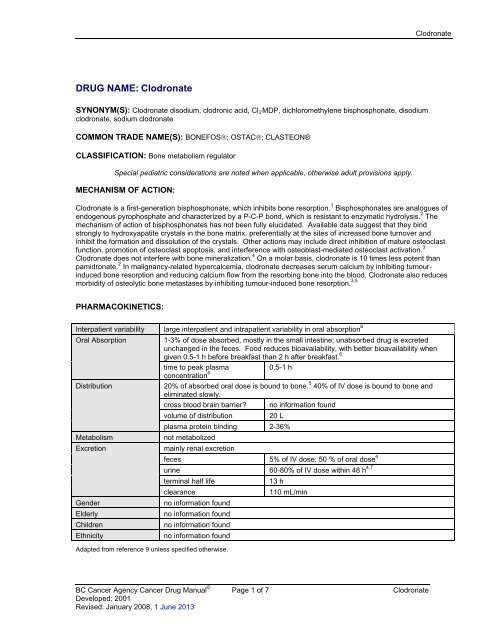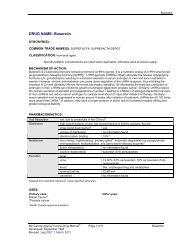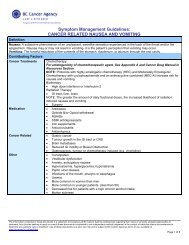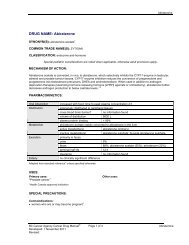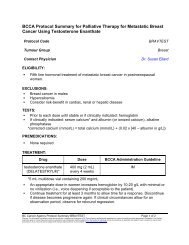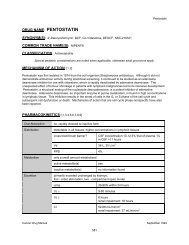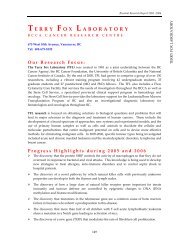Clodronate - BC Cancer Agency
Clodronate - BC Cancer Agency
Clodronate - BC Cancer Agency
Create successful ePaper yourself
Turn your PDF publications into a flip-book with our unique Google optimized e-Paper software.
<strong>Clodronate</strong>DRUG NAME: <strong>Clodronate</strong>SYNONYM(S): <strong>Clodronate</strong> disodium, clodronic acid, Cl 2 MDP, dichloromethylene bisphosphonate, disodiumclodronate, sodium clodronateCOMMON TRADE NAME(S): BONEFOS; OSTAC; CLASTEON®CLASSIFICATION: Bone metabolism regulatorSpecial pediatric considerations are noted when applicable, otherwise adult provisions apply.MECHANISM OF ACTION:<strong>Clodronate</strong> is a first-generation bisphosphonate, which inhibits bone resorption. 1 Bisphosphonates are analogues ofendogenous pyrophosphate and characterized by a P-C-P bond, which is resistant to enzymatic hydrolysis. 2 Themechanism of action of bisphosphonates has not been fully elucidated. Available data suggest that they bindstrongly to hydroxyapatite crystals in the bone matrix, preferentially at the sites of increased bone turnover andinhibit the formation and dissolution of the crystals. Other actions may include direct inhibition of mature osteoclastfunction, promotion of osteoclast apoptosis, and interference with osteoblast-mediated osteoclast activation. 3<strong>Clodronate</strong> does not interfere with bone mineralization. 4 On a molar basis, clodronate is 10 times less potent thanpamidronate. 2 In malignancy-related hypercalcemia, clodronate decreases serum calcium by inhibiting tumourinducedbone resorption and reducing calcium flow from the resorbing bone into the blood. <strong>Clodronate</strong> also reducesmorbidity of osteolytic bone metastases by inhibiting tumour-induced bone resorption. 3,5PHARMACOKINETICS:Interpatient variability large interpatient and intrapatient variability in oral absorption 6Oral Absorption1-3% of dose absorbed, mostly in the small intestine; unabsorbed drug is excretedunchanged in the feces. Food reduces bioavailability, with better bioavailability whengiven 0.5-1 h before breakfast than 2 h after breakfast. 6time to peak plasma0.5-1 hconcentration 6Distribution20% of absorbed oral dose is bound to bone. 5 40% of IV dose is bound to bone andeliminated slowly.cross blood brain barrier? no information foundvolume of distribution20 Lplasma protein binding 2-36%Metabolismnot metabolizedExcretionmainly renal excretionfeces 5% of IV dose; 50 % of oral dose 4urine 60-80% of IV dose within 48 h 4,7terminal half life13 hclearance110 mL/minGenderno information foundElderlyno information foundChildrenno information foundEthnicityno information foundAdapted from reference 9 unless specified otherwise.<strong>BC</strong> <strong>Cancer</strong> <strong>Agency</strong> <strong>Cancer</strong> Drug Manual © Page 1 of 7 <strong>Clodronate</strong>Developed: 2001Revised: January 2008, 1 June 2013
<strong>Clodronate</strong>USES:Primary uses:*Malignancy-related hypercalcemia 8-11*Osteolytic bone metastases 12-15*Health Canada Therapeutic Products Programme approved indicationNo pediatric indications.SPECIAL PRECAUTIONS:Contraindicated in patients who have a history of hypersensitivity reaction to clodronate or other bisphosphonatesand in patients with severe renal dysfunction (serum creatinine > 440 mol/L). Oral clodronate is alsocontraindicated in patients with severe inflammation of the GI tract. 5,7Hydration: For acute malignancy-related hypercalcemia, patients must be adequately hydrated with intravenous NSbefore and during clodronate treatment to expand intracellular volume and to increase renal calciumclearance. 7,16 The optimum NS infusion rate is determined by the severity of hypercalcemia, the degree ofdehydration and the ability of the patient to tolerate fluid. Infusion rate of 200-300 mL/h has been commonly used.However, these infusion rates may require adjustment if signs and symptoms of fluid overload occur. 16Carcinogenicity: Not carcinogenic in animal studies at doses 45-400 mg/kg/day. 5Mutagenicity: Not mutagenic in Ames test or in mammalian in vitro mutation test. Not clastogenic in mammalian invitro or in vivo chromosome tests. 7Fertility: No information found.Pregnancy: Animal studies showed decreased maternal weight gains, decreased fetal weights and delayed fetalossification. The safety and efficacy in humans have not been established. 7 Drugs should be given only if thepotential benefit justifies the potential risk to the fetus.Breastfeeding is not recommended due to the potential secretion into breast milk. 7SIDE EFFECTS:ORGAN SITESIDE EFFECTallergy/immunology hypersensitivity (rare) 5dermatology/skin extravasation hazard: none 17rash (rare) 18endocrine increased parathyroid hormone level (0.6%)gastrointestinal emetogenic potential: nonemetogenicgastrointestinal disturbances with oral route, including nausea, vomiting, gastric pain,diarrhea (2-10%) 3,7metabolic/laboratory hypocalcemia (3%) 19musculoskeletal osteonecrosis of the jaw 20,21renal/genitourinaryacute renal failure (rare) 4transient proteinuria (rare) 5,7<strong>BC</strong> <strong>Cancer</strong> <strong>Agency</strong> <strong>Cancer</strong> Drug Manual © Page 2 of 7 <strong>Clodronate</strong>Developed: 2001Revised: January 2008, 1 June 2013
<strong>Clodronate</strong>ORGAN SITESIDE EFFECTtransient increase of serum creatinine (0.6%) 19Adapted from reference 9 unless specified otherwise.Osteonecrosis of the jaw (ONJ) has been reported. 20,21 Refer to Bisphosphonates and Osteonecrosis of the Jaw inthe Oral/Dental Care section of the <strong>Cancer</strong> Management Guidelines for more detailed information.Bronchoconstriction was described in one case report. A patient with a history of acetylsalicylic acid-sensitiveasthma developed dyspnea and wheezing 10 minutes after starting clodronate 200 mg IV infusion. The infusion wasstopped and the patient recovered after inhalation of salbutamol. When rechallenged with oral clodronate 400 mg,her forced expiratory values decreased significantly from baseline. The mechanism of bronchoconstriction isunclear. 22Gastrointestinal disturbances such as nausea, vomiting, gastric pain, and diarrhea, are generally associated withhigher oral doses and may be minimized by reducing or dividing the total daily dose, or temporarily interruptingtreatment. 4,5Hypocalcemia: Symptomatic hypocalcemia is rare. 19 Symptoms include abdominal cramps, confusion, musclespasms, lethargy and irritability. 23 Risk factors include concurrent use of aminoglycosides 24 or other calcium-loweringagents such as corticosteroids, phosphate, calcitonin, mithramycin and loop-diuretics. 7 Patients with a history ofsmall bowel resection or Crohn’s disease may also be more prone to hypocalcemia with oral clodronate. 23Symptomatic hypocalcemia can be treated with oral or IV calcium supplement. 5,23INTERACTIONS:AGENT EFFECT MECHANISM MANAGEMENTantacids; calcium, iron,magnesium or aluminumcontainingpreparations 7aminoglycosides (eg,amikacin, gentamycin,tobramycin) 24,25vitamin D-containingpreparations 26calcium-lowering agents(eg, corticosteroids,phosphate, calcitonin,mithramycin, loopdiuretics)5,7estramustine 27decreased therapeuticeffect of oral clodronateincreased hypocalcemiceffect of clodronatemay decreasehypocalcemic effect ofclodronateincreased hypocalcemiceffect of clodronateincreased serumconcentration ofestramustinedecreased absorption oforal clodronateadditiveantagonisticadditivepossibly by increasing oralbioavailability ofestramustineavoid concurrentadministration, take atleast 2 hours apartuse with caution duringconcurrent therapy and inpatients with prior therapyof clodronate oraminoglycosidesavoid concurrent therapyuse with caution duringconcurrent therapyavoid concurrent therapyoutside clinical trials<strong>BC</strong> <strong>Cancer</strong> <strong>Agency</strong> <strong>Cancer</strong> Drug Manual © Page 3 of 7 <strong>Clodronate</strong>Developed: 2001Revised: January 2008, 1 June 2013
<strong>Clodronate</strong>SUPPLY AND STORAGE:Capsules: BONEFOS: 400 mg; inactive ingredients include lactose. Store at room temperature. 7OSTAC: 400 mg; inactive ingredients do not include lactose. Store at room temperature. Protect from highhumidity. 5CLASTEON ® : 400 mg; inactive ingredients do not include lactose. Store at room temperature and protect from highhumidity. 28SOLUTION PREPARATION AND COMPATIBILITY:For basic information on solution preparation and compatibility, see Chemotherapy Chart in Appendix.Injection: BONEFOS: 5 mL ampoule; each mL contains 60 mg of anhydrous disodium clodronate. Store at roomtemperature. 7OSTAC: 10 mL ampoule; each mL contains 30 mg of anhydrous disodium clodronate. Store at room temperatureand protect from high humidity. 5CLASTEON ® : 10 mL ampoule; each mL contains 30 mg of anhydrous clodronate disodium. Store at roomtemperature and protect from high humidity. 28Diluted solution for infusion: BONEFOS: dilute 300 mg or 1500 mg in 500 mL of NS or D5W prior to infusion. 7,8Diluted solution is stable for 24 hours at room temperature. 7OSTAC: dilute 300 or 1500 mg in 500 mL of NS or D5W prior to infusion. Diluted solution is stable for 12 hours atroom temperature. 5CLASTEON ® : dilute 300 or 1500 mg in 500 mL of NS or D5W prior to infusion. 28 Diluted solution is stable for 12hours at room temperature. 28Compatibility: <strong>Clodronate</strong> should not be mixed with calcium-containing IV solutions such as Ringer’s solution. 7PARENTERAL ADMINISTRATION:<strong>BC</strong>CA administration guideline noted in bold, italicsSubcutaneous investigational, 1500 mg in 1L NS by SC infusion over 12 or 24 h 17,29Intramuscular investigational, has been used in clinical trials at lower dosages 30-32Direct intravenousnot recommended since severe local reactions and thrombophlebitis may occur dueto high local concentration; also rapid bolus injection may cause acute renal failure. 7Intermittent infusion 300 mg in 500 mL NS or D5W over 2 h 5 ;> 300 mg in 500 mL NS or D5W over 3-4 h 5,33• can also be given over 3-9 h 5,33,34Continuous infusion no information foundIntraperitonealno information foundIntrapleuralno information foundIntrathecalno information foundIntra-arterialno information foundIntravesicalno information found<strong>BC</strong> <strong>Cancer</strong> <strong>Agency</strong> <strong>Cancer</strong> Drug Manual © Page 4 of 7 <strong>Clodronate</strong>Developed: 2001Revised: January 2008, 1 June 2013
<strong>Clodronate</strong>DOSAGE GUIDELINES:Refer to protocol by which patient is being treated.Adults:<strong>BC</strong>CA usual dose noted in bold, italicsCycle Length:Oral:Osteolytic bone metastases 1600 mg (range 800-3200 mg) PO in single or two divided doses daily 3,7,12Maximal recommended daily dose is 3200 mg. 5,7 Round dose to the nearest400 mg.Administer on empty stomach at least 1 hour before or 1-2 hours after food. 5,7,35For patients who are awake in the middle of the night, clodronate may be takenat that time as long as the drug is taken 1 hour before or 1-2 hours after eating.<strong>Clodronate</strong> may also be taken 30 minutes before eating if necessary as thebioavailability is comparable to that taken 1 hour before eating. 6For patients with swallowing problems, capsules may be opened and mixed witha small amount of water for administration. However, capsule content is acidicand may cause burning in the esophagus; bioavailability of this administrationroute has not been determined. 35,36Maintenance for malignancyrelatedhypercalcemiasame as aboveIntravenous:Osteolytic bone metastases 4 weeks: 1500 mg IV for one dose 37,38Malignancy-relatedhypercalcemiaDosage in renal failure:Dosage in hepatic failure:300 mg IV once daily for 5 consecutive days (range 3-10 days) 3,5 ; OR1500 mg IV for one dose 5,8Reduce dose by 50% with CrCl 10-30 mL/min. 4 <strong>Clodronate</strong> is contraindicated inpatients with CrCl < 10 mL/min or serum creatinine > 440 mol/L. 4,7no adjustment requiredDosage in dialysis: hemodialysis: No adjustment required with single IV dose if given at thebeginning of dialysis. 39,40 No information on oral clodronate.CAPD: Reduce IV dose by 50%, as CAPD removes clodronatepoorly. Long-term treatment may cause pronouncedclodronate deposition in skeleton. 41 No information on oralclodronate.REFERENCES:1. Lipton A. AREDIA® : the once-monthly infusion for the treatment of bone metastases. Curr Opin Oncol 1998;10(Suppl 1):S1-5.2. Fleisch H. Bisphosphonates. Pharmacology and use in the treatment of tumour-induced hypercalcaemic and metastatic bonedisease. Drugs 1991;42(6):919-944.3. Plosker GL, Goa KL. <strong>Clodronate</strong>. A review of its pharmacological properties and therapeutic efficacy in resorptive bone disease.Drugs 1994;47(6):945-82; Drugs 1994 Jun;47(6):945-82.<strong>BC</strong> <strong>Cancer</strong> <strong>Agency</strong> <strong>Cancer</strong> Drug Manual © Page 5 of 7 <strong>Clodronate</strong>Developed: 2001Revised: January 2008, 1 June 2013
<strong>Clodronate</strong>4. Hurst M, Noble S. <strong>Clodronate</strong>: a review of its use in breast cancer. Drugs and Aging 1999;15(2):143-67; Drugs Aging 1999Aug;15(2):143-67.5. Hoffmann La Roche Ltd. Ostac product monograph. Mississauga, Ontario; 04 June 1998.6. Laitinen K, Patronen A, Harju P, et al. Timing of food intake has a marked effect on the bioavailability of clodronate. Bone2000;27(2):293-6; Bone 2000 Aug;27(2):293-6.7. Aventis. Bonefos product monograph. Laval, Quebec; 25 July 2000.8. O'Rourke NP, McCloskey EV, Vasikaran S, et al. Effective treatment of malignant hypercalcaemia with a single intravenousinfusion of clodronate. British Journal of <strong>Cancer</strong> 1993;67(3):560-3; Br J <strong>Cancer</strong> 1993 Mar;67(3):560-3.9. Purohit OP, Radstone CR, Anthony C, et al. A randomised double-blind comparison of intravenous pamidronate and clodronatein the hypercalcaemia of malignancy. Br J <strong>Cancer</strong> 1995;72(5):1289-1293.10. Rotstein S, Glas U, Eriksson M, et al. Intravenous clodronate for the treatment of hypercalcaemia in breast cancer patientswith bone metastases--a prospective randomised placebo-controlled multicentre study. European Journal of <strong>Cancer</strong> 1992;28A(4-5):890-3; Eur J <strong>Cancer</strong> 1992;28A(4-5):890-3.11. Watters J, Gerrand G, Dodwell D. The management of malignant hypercalcaemia. Drugs 1996;52(6):837-848.12. Paterson AH, Powles TJ, Kanis JA, et al. Double-blind controlled trial of oral clodronate in patients with bone metastases frombreast cancer. Journal of Clinical Oncology 1993;11(1):59-65; J Clin Oncol 1993 Jan;11(1):59-65.13. Diel IJ, Solomayer EF, Costa SD, et al. Reduction in new metastases in breast cancer with adjuvant clodronate treatment [seecomments]. New England Journal of Medicine 1998;339(6):357-63; N Engl J Med 1998 Aug 6;339(6):357-63.14. Lahtinen R, Laakso M, Palva I, et al. Randomised, placebo-controlled multicentre trial of clodronate in multiple myeloma.Finnish Leukaemia Group [published erratum appears in Lancet 1992 Dec 5;340(8832):1420] [see comments]. Lancet1992;340(8827):1049-52; Lancet 1992 Oct 31;340(8827):1049-52.15. Elomaa I, Kylmala T, Tammela T, et al. Effect of oral clodronate on bone pain. A controlled study in patients with metastaticprostatic cancer. International Urology and Nephrology 1992;24(2):159-66; Int Urol Nephrol 1992;24(2):159-66.16. Chisholm MA, Mulloy AL, Taylor AT. Acute management of cancer-related hypercalcemia. Ann Pharmacother 1996;30(5):507-513.17. Walker P, Watanabe S, Lawlor P, et al. Subcutaneous clodronate: a study evaluating efficacy in hypercalcemia of malignancyand local toxicity. Annals of Oncology 1997;8(9):915-6; Ann Oncol 1997 Sep;8(9):915-6.18. Pajus I, Lestang P, Liote F, et al. Erythroderma after clodronate treatment. BMJ 1993;307(6902):484-BMJ 1993 Aug21;307(6902):484.19. Mian M, Beghe F, Caprio A, et al. Tolerability and safety of clodronate therapy in bone diseases. International Journal ofClinical Pharmacology Research 1991;11(2):107-14; Int J Clin Pharmacol Res 1991;11(2):107-14.20. Montazeri AH, Erskine JG, McQuaker IG, et al. Oral sodium clodronate induced osteonecrosis of the jaw in a patient withmyeloma. Eur J Haematol 2007;79(1):69-71.21. Bayer. BONEFOS® product monograph. Toronto, Ontario; 22 February 2007.22. Rolla G, Bucca C, Brussino L. Bisphosphonate-induced bronchoconstriction in aspirin-sensitive asthma [letter] [seecomments]. Lancet 1994;343(8894):426-7; Lancet 1994 Feb 12;343(8894):426-7.23. Johnson MJ, Fallon MT. Symptomatic hypocalcemia with oral clodronate. Journal of Pain and Symptom Management1998;15(2):140-2; J Pain Symptom Manage 1998 Feb;15(2):140-2.24. Mayordomo JI, Rivera F. Severe hypocalcaemia after treatment with oral clodronate and aminoglycoside [letter]. Annals ofOncology 1993;4(5):432-3; Ann Oncol 1993 May;4(5):432-3.25. Pedersen-Bjergaard U, Myhre J. Severe hypocalcaemia [corrected] after treatment with diphosphonate and aminoglycoside.BMJ 1991;302(6771):295.26. <strong>Clodronate</strong>. USP DI. Volume I. Drug information for the health care professional. 20th ed. Englewood, Colorado: Micromedex,Inc.; 2000.27. Kylmala T, Castren-Kortekangas P, Seppanen J, et al. Effect of concomitant administration of clodronate and estramustinephosphate on their bioavailability in patients with metastasized prostate cancer. Pharmacology & Toxicology 1996;79(3):157-60;Pharmacol Toxicol 1996 Sep;79(3):157-60.28. Oryx Pharmaceuticals Inc. Clasteon Product Monograph. Mississauga, Ontario; 25 November 2004.29. Walker P, Watanabe S, Lawlor P, et al. Subcutaneous clodronate [letter]. Lancet 1996;348(9023):345-6.30. Rossini M, V B, Gatti D, et al. Intramuscular clodronate therapy in postmenopausal osteoporosis. Bone 1999;24(2):125-9;Bone 1999 Feb;24(2):125-9.31. Francini G, Gonnelli S, Petrioli R, et al. Treatment of bone metastases with dichloromethylene bisphosphonate. Journal ofClinical Oncology 1992;10(4):591-8; J Clin Oncol 1992 Apr;10(4):591-8.32. Martoni A, Guaraldi M, Camera P, et al. Controlled clinical study on the use of dichloromethylene diphosphonate in patientswith breast carcinoma metastasizing to the skeleton. Oncology 1991;48(2):97-101; Oncology 1991;48(2):97-101.33. Ernst DS, Brasher P, Hagen N, et al. A randomized, controlled trial of intravenous clodronate in patients with metastatic bonedisease and pain. Journal of Pain & Symptom Management 1997;13(6):319-26; J Pain Symptom Manage 1997 Jun;13(6):319-26.34. Bonjour JP, Rizzoli R. Treatment of hypercalcaemia of malignancy with clodronate. Bone 1991;12(Suppl 1):S19-23; Bone1991;12 Suppl 1:S19-23.35. Aventis. Personal communication. 19 February 2001.36. Hoffmann La Roche Ltd. Personal communication. 19 February 2001.37. B.C. <strong>Cancer</strong> <strong>Agency</strong> Breast Tumour Group. <strong>BC</strong>CA protocol summary for therapy of bone metastases in breast cancer usingoral clodronate (BRAVCLOD). Vancouver, British Columbia: <strong>BC</strong> <strong>Cancer</strong> <strong>Agency</strong>; 01 February 2001.38. Diel IJ, Marschner N, Kindler M, et al. Continual oral versus intravenous interval therapy with bisphosphonates in patients withbreast cancer and bone metastases. Proc Am Soc Clin Oncol 1999;18:(abstract 488)-Proc Am Soc Clin Oncol 1999;18:abstract488.<strong>BC</strong> <strong>Cancer</strong> <strong>Agency</strong> <strong>Cancer</strong> Drug Manual © Page 6 of 7 <strong>Clodronate</strong>Developed: 2001Revised: January 2008, 1 June 2013
<strong>Clodronate</strong>39. Ala-Houhala I, Saha H, Liukko-Sipi S, et al. Pharmacokinetics of clodronate in haemodialysis patients. Nephrology, Dialysis,Transplantation 1999;14(3):699-705; Nephrol Dial Transplant 1999 Mar;14(3):699-705.40. Beigel AE, Rienhoff E, Olbricht CJ. Removal of clodronate by haemodialysis in end-stage renal disease patients. Nephrology,Dialysis, Transplantation 1995;10(12):2266-8; Nephrol Dial Transplant 1995 Dec;10(12):2266-8.41. Saha HH, Ala-Houhala IO, Liukko-Sipi SH, et al. Pharmacokinetics of clodronate in peritoneal dialysis patients. PeritonealDialysis International 1998;18(2):204-9; Perit Dial Int 1998 Mar-Apr;18(2):204-9.<strong>BC</strong> <strong>Cancer</strong> <strong>Agency</strong> <strong>Cancer</strong> Drug Manual © Page 7 of 7 <strong>Clodronate</strong>Developed: 2001Revised: January 2008, 1 June 2013


